Papers by David Grembowski
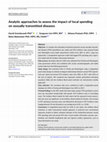
Health Services Research, Jan 17, 2022
ObjectiveTo compare the estimated associations between annual sexually transmitted diseases (STD)... more ObjectiveTo compare the estimated associations between annual sexually transmitted diseases (STD) expenditures per capita and STD incidence rates among Florida and Washington local health departments (LHDs) from 2001 to 2017, using two approaches—a longitudinal regression model with lagged STD spending and a regression model with the Arellano–Bond panel estimator.Data sourcesSecondary data for LHDs were obtained from Florida and Washington state government offices and combined with county sociodemographic and health system data from the federal government.Study designWe examined LHDs in Florida and Washington using a longitudinal panel study design to estimate ecological relationships between annual STD expenditures per capita and annual STD incidence rates from 2001 to 2017, with LHDs as the unit of analysis. We compared two regression models: generalized estimating equations (GEE) and the Arellano–Bond panel estimator (an instrumental variable approach).Data collectionThe secondary data were combined to build a longitudinal panel database for LHDs in Florida and Washington from 2001 to 2017.Principal findingsIn the GEE model with both states, greater STD spending in a prior year was associated unexpectedly with greater STD incidence rates in succeeding years. The Arellano–Bond models for both states had the expected inverse associations but were not significant. In the Arellano–Bond models for Florida, a $1 increase in STD spending in previous years was followed by decreases in STD incidence rates ranging between 29 and 58 points in succeeding years (0.09 ≥ p ≥ 0.04).ConclusionsIn longitudinal panel data for LHDs in two states, the Arellano–Bond estimator, or other instrumental variable approach, is preferred over conventional regression models to obtain unbiased estimates of the relationship between annual STD spending rates and annual STD rates. Future studies will require accurate, standardized, and detailed longitudinal data and rigorous analytic approaches, such as those illustrated in our study.
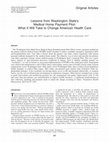
Population Health Management, Aug 1, 2015
The Washington State Multi-Payer Medical Home Reimbursement Pilot (Pilot) tested a payment method... more The Washington State Multi-Payer Medical Home Reimbursement Pilot (Pilot) tested a payment method for the patient-centered medical home (PCMH) model intended to reduce avoidable emergency department (ED) and hospitalization rates. Very little is known about the primary care clinic (clinic) experience with various payment methods designed for the medical home model. The objective was to elicit and describe the primary care clinic experience among various medical groups in Washington State's payment Pilot. This was a qualitative analysis of semi-structured interviews conducted in January 2014 to identify enabling features (or ''facilitators'') as well as barriers to successful implementation of PCMH in this multi-payer pilot. Participants were clinical and administrative staff of Pilot clinics representing various types of health systems under 8 parent organizations across Washington State. Pilot clinics across Washington State chose evidence-based population health strategies to achieve Pilot targets. Pilot clinics encountered more barriers than facilitators when implementing strategies. A key facilitator was having timely access to ED and hospital clinical data. A common barrier was the cost of infrastructure development to implement strategies. Other barriers included lack of data to guide interventions and insufficient payment for care management and quality improvement work. It will take more than just primary care transformation to improve health outcomes-a significant transformation in data collection, reporting and payment needs to match the change occurring in clinics.

PubMed, Apr 21, 2005
Purpose: Dentists' and parents' assessment of primary maxillary incisors regarding attractiveness... more Purpose: Dentists' and parents' assessment of primary maxillary incisors regarding attractiveness, perceived health, and treatment preferences were investigated in this study. Methods: Sample groups of 103 general dentists, 67 pediatric dentists, 97 parents of children in low-income families and 112 parents of children in high-income families completed questionnaires presenting color photographs and radiographs of maxillary incisors. Questions addressed treatment need, health beliefs, and demographics. Results: All groups recognized grossly carious teeth and carious teeth with visible sinus tracts as unhealthy and unattractive. All agreed that grossly carious teeth warranted extraction (dentists = 92%, parents = 73%). For carious teeth with sinus tracts, dentists favored extraction and restorations while parents favored fluoride application. Dentists rated a dark incisor as healthy and not requiring treatment. Parents rated a dark incisor as neutral for attractiveness and health, but favored extraction or restoration. All groups found anterior steel crowns esthetically unacceptable. Trust of the dentist, pain for the child, and dentist skill was important for parents in treatment plan acceptance. Conclusions: A dentist's inexperience in pediatrics may result in a failure to diagnose or recognize the significance of some conditions. Proper parental education can better inform parents on dental conditions requiring prompt professional attention. Although parents today are more involved in clinical decision-making, they still rely on the dentist's expertise and advice.

PubMed, Feb 1, 1987
As the number of families with dental insurance and expenditures for dental care has increased ov... more As the number of families with dental insurance and expenditures for dental care has increased over the past two decades, so has interest in determining cost-sharing effects on dental demand among insureds. Using a representative sample of Pennsylvania Blue Shield children insureds during 1980, we estimate cost-sharing effects on dental demand for basic (diagnostic, preventive, restorative, endodontic, and extraction services) and orthodontic care. Results indicate that cost-sharing has little influence on the probability of using any dental services and basic expenditures. However, the probability of using orthodontic services decreases 2.1 percent when the proportion of orthodontic expenditures paid by the parent increases 10 percent. By reducing the cost of care, cost-sharing reduces social class differences in dental demand common in unisured populations, likely producing public oral health benefits.

Social Science & Medicine, Nov 1, 2015
This study tested a behavioral intervention to increase dental attendance among rural Oregonian l... more This study tested a behavioral intervention to increase dental attendance among rural Oregonian low-income women and their children. It utilized a multi-site, single-blind, randomized trial design. Four hundred women were randomized into one of four conditions to receive prenatal or postpartum motivational interviewing/counseling (MI) or prenatal or postpartum health education (HE). Counselors also functioned as patient navigators. Primary outcomes were dental attendance during pregnancy for the mother and for the child by age 18 months. Attendance was obtained from the Oregon Division of Medical Assistance Programs and participant self-report. Statewide self-reported utilization data were obtained from the Oregon Pregnancy Risk Assessment Monitoring System (PRAMS). Maternal attendance was 92% in the prenatal MI group and 94% in the prenatal HE group (RR = 0.98; 95% CI = 0.93-1.04). Children's attendance was 54% in postpartum MI group and 52% in the postpartum HE group (RR = 1.03; 95% CI = 0.82-1.28). Compared to statewide PRAMS, attendance was higher during pregnancy for study mothers (45% statewide; 95% CI = 40-50%) and for their children by 24 months (36% statewide; 95% CI = 27-44%). MI did not lead to greater attendance when compared to HE alone and cost more to implement. High attendance may be attributable to the counselors' patient navigator function.
Journal of Health Care for the Poor and Underserved, Nov 1, 2022

Journal of Health Care for the Poor and Underserved, 2021
The Washington State Innovation Models (SIM) $65 million Test Award from the Center for Medicare ... more The Washington State Innovation Models (SIM) $65 million Test Award from the Center for Medicare & Medicaid Services' Innovation Center is a statewide intervention expected to improve population health, quality of care, and cost growth through four initiatives: 1) regional accountable communities of health linking health and social services to address local needs; 2) a practice transformation support hub; 3) four value-based payment reform pilot projects mainly in state employee and Medicaid populations; and 4) data and analytic infrastructure development to support system transformation with common measures. We develop a conceptual model based on diffusion theory and apply the RE-AIM evaluation framework (Reach, Effectiveness, Adoption, Implementation, and Maintenance) to structure our evaluation. We find that in three years (2016-2018), SIM built the infrastructure for system transformation and increased Washington's readiness for health system change in the next decade. However, the initiatives have not spread statewide, which may take over 10 years.

Quality management in health care, Oct 1, 2008
The Institute of Medicine argues that poorly designed delivery systems are a major cause of low-q... more The Institute of Medicine argues that poorly designed delivery systems are a major cause of low-quality care in the United States but does not present methods for evaluating whether its recommendations, when implemented by a health care organization, actually improve quality of care. We describe how time-series study designs using individual-level longitudinal data can be applied to address methodological challenges in our evaluation of the impact of the Group Health Cooperative "Access Initiative," an integrated set of 7 "patient-centered" reforms in its integrated delivery system that are consistent with the Institute of Medicine's recommendations. The methods may be generalizable to evaluating similar…

Health Services Research, Oct 1, 2008
Objective. To estimate the joint effect of a multifaceted access intervention on primary care phy... more Objective. To estimate the joint effect of a multifaceted access intervention on primary care physician (PCP) productivity in a large, integrated prepaid group practice. Data Sources. Administrative records of physician characteristics, compensation and full-time equivalent (FTE) data, linked to enrollee utilization and cost information. Study Design. Dependent measures per quarter per FTE were office visits, work relative value units (WRVUs), WRVUs per visit, panel size, and total cost per member per quarter (PMPQ), for PCPs employed 40.25 FTE. General estimating equation regression models were included provider and enrollee characteristics. Principal Findings. Panel size and RVUs per visit rose, while visits per FTE and PMPQ cost declined significantly between baseline and full implementation. Panel size rose and visits per FTE declined from baseline through rollout and full implementation. RVUs per visit and RVUs per FTE first declined, and then increased, for a significant net increase of RVUs per visit and an insignificant rise in RVUs per FTE between baseline and full implementation. PMPQ cost rose between baseline and rollout and then declined, for a significant overall decline between baseline and full implementation. Conclusions. This organization-wide access intervention was associated with improvements in several dimensions in PCP productivity and gains in clinical efficiency.
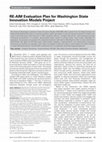
Quality management in health care, Apr 1, 2020
The State of Washington received a State Innovation Models (SIM) $65 million award from the feder... more The State of Washington received a State Innovation Models (SIM) $65 million award from the federal Centers for Medicare & Medicaid Services to improve population health and quality of care and reduce the growth of health care costs in the entire state, which has over 7 million residents. SIM is a "complex intervention" that implements several interacting components in a complex, decentralized health system to achieve goals, which poses challenges for evaluation. Our purpose is to present the state-level evaluation methods for Washington's SIM, a 3-year intervention (2016-2018). We apply the RE-AIM (reach, effectiveness, adoption, implementation, and maintenance) evaluation framework to structure our evaluation. We create a conceptual model and a plan to use multiple and mixed methods to study SIM performance in the RE-AIM components from a statewide, population-based perspective.

Health Services Research, Apr 16, 2021
ObjectiveTo estimate the impact of a new, two‐sided risk model accountable care network (ACN) on ... more ObjectiveTo estimate the impact of a new, two‐sided risk model accountable care network (ACN) on Washington State employees and their families.Data Sources/Study SettingAdministrative data (January 2013‐December 2016) on Washington State employees.Study DesignWe compared monthly health care utilization, health care intensity as measured through proxy pricing, and annual HEDIS quality metrics between the five intervention counties to 13 comparison counties, analyzed separately by age categories (ages 0‐5, 6‐18, 19‐26, 18‐64).Data Collection/Extraction MethodsWe used difference‐in‐difference methods and generalized estimating equations to estimate the effects after 1 year of implementation for adults and children.Principal FindingsWe estimate a 1‐2 percentage point decrease in outpatient hospital visits due to the introduction of ACNs (adults: −1.8, P < .01; age 0‐5: −1.2, P = .07; age 6‐18: −1.2, P = .06; age 19‐26; −1.2, P < .01). We find changes in primary and specialty care office visits; the direction of impact varies by age. Dependents age 19‐26 were also responsive with inpatient admissions declines (−0.08 percentage points, P = .02). Despite changes in utilization, there was no evidence of changes in intensity of care and mixed results in the quality measures.ConclusionsWashington's state employee ACN introduction changed health care utilization patterns in the first year but was not as successful in improving quality.
Journal of Dental Education, 1997
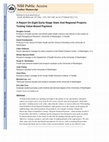
Health Affairs, May 1, 2013
To help contain health care spending and improve the quality of care, practitioners and policy ma... more To help contain health care spending and improve the quality of care, practitioners and policy makers are trying to move away from fee-for-service toward value-based payment, which links providers' reimbursement to the value, rather than the volume, of services delivered. With funding from the Robert Wood Johnson Foundation, eight grantees across the country are designing and implementing value-based payment reform projects. For example, in Salem, Oregon, the Physicians Choice Foundation is testing "Program Oriented Payments," which include incentives for providers who follow a condition-specific program of care designed to meet goals set jointly by patient and provider. In this article we describe the funding rationale and the specific objectives, strategies, progress, and early stages of implementation of the eight projects. We also share some early lessons and identify prerequisites for success, such as ensuring that providers have broad and timely access to data so they can meet patients' needs in cost-effective ways.

Medical Care, May 1, 1997
The authors determine whether prevention influences the use of health services. Fluoridation&... more The authors determine whether prevention influences the use of health services. Fluoridation&#39;s effect on restorative dental demand among 972 Washington state employees and spouses, aged 20 to 34 years, in two fluoridated communities and a nonfluoridated community was examined. At baseline, adults were interviewed by telephone, and oral assessments were conducted to measure personal characteristics, lifetime exposure to fluoridated water, oral disease, and the quality of restorations. Adults were followed for 2 years to measure dental demand from dental claims. Each adult&#39;s baseline and claims data were linked with provider and practice variables collected from the dentist who provided treatment. Relative to adults with no lifetime exposure to fluoridated water, adults drinking fluoridated water for half or more of their lives had less disease at baseline and a lower but nonsignificant probability of receiving a restoration in the follow-up period. In the 2-year follow-up period, however, more than half of the restorations were performed to replace fillings of satisfactory or ideal quality at baseline. When only teeth with decay and unsatisfactory fillings at baseline were considered, adults with high fluoridation exposure had a lower probability of receiving a restoration than adults with no exposure. Market effects also were detected in demand equations; relative to adults in the nonfluoridated community, adults residing in the fluoridated community with a large dentist supply received a greater number of restorations, suggesting potential supplier-induced demand from less disease and fewer patients. Among adults aged 20 to 34 years with private dental insurance, fluoridation reduces oral disease but may or may not reduce use of restorative services, depending on dentists&#39; clinical decisions.

Medical Care Research and Review, Nov 5, 2015
This article develops a conceptual framework for implementation of value-based payment (VBP) refo... more This article develops a conceptual framework for implementation of value-based payment (VBP) reform and then draws on that framework to systematically examine six distinct multi-stakeholder coalition VBP initiatives in three different regions of the United States. The VBP initiatives deploy the following payment models: reference pricing, &amp;amp;amp;amp;amp;amp;amp;amp;amp;amp;amp;amp;amp;amp;amp;amp;amp;amp;amp;amp;amp;amp;quot;shadow&amp;amp;amp;amp;amp;amp;amp;amp;amp;amp;amp;amp;amp;amp;amp;amp;amp;amp;amp;amp;amp;amp;quot; primary care capitation, bundled payment, pay for performance, shared savings within accountable care organizations, and global payment. The conceptual framework synthesizes prior models of VBP implementation. It describes how context, project objectives, payment and care delivery strategies, and the barriers and facilitators to translating strategy into implementation affect VBP implementation and value for patients. We next apply the framework to six case examples of implementation, and conclude by discussing the implications of the case examples and the conceptual framework for future practice and research.
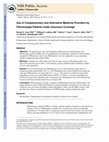
Arthritis & Rheumatism, 2007
Objective-To quantify how visits and expenditures differ between insured patients with fibromyalg... more Objective-To quantify how visits and expenditures differ between insured patients with fibromyalgia syndrome (FMS) who use complementary and alternative medicine (CAM) providers compared to FMS patients who do not. FMS patients were also compared to an age and gender matched comparison group without FMS. Methods-Calendar year 2002 claims data from two large insurers in Washington State were analyzed for provider type (CAM vs. conventional), patient comorbid medical conditions, number of visits, and expenditures. Results-Use of CAM providers by FMS patients was two and a half times higher than in a comparison group without FMS. (56% vs. 21%) FMS patients who used CAM had more health care visits than FMS patients not using CAM (34 vs. 23, p < .001); however, CAM users had similar expenditures to non-users among FMS patients ($4638 vs. $4728, n.s.), because expenditure per CAM visit is lower than expenditure per conventional visit. FMS patients who used CAM also had heavier overall disease burdens than those not using CAM. Conclusion-With insurance coverage, a majority of FMS patients will use CAM providers. The sickest patients use more CAM and this leads to an increased number of health care visits. However, CAM use is not associated with higher overall expenditures. Until a cure for FMS is found, CAM providers may offer an economical alternative for FMS patients seeking symptomatic relief.
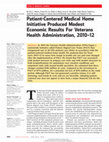
Health Affairs, Jun 1, 2014
In 2010 the Veterans Health Administration (VHA) began a nationwide initiative called Patient Ali... more In 2010 the Veterans Health Administration (VHA) began a nationwide initiative called Patient Aligned Care Teams (PACT) that reorganized care at all VHA primary care clinics in accordance with the patient-centered medical home model. We analyzed data for fiscal years 2003-12 to assess how trends in health care use and costs changed after the implementation of PACT. We found that PACT was associated with modest increases in primary care visits and with modest decreases in both hospitalizations for ambulatory care-sensitive conditions and outpatient visits with mental health specialists. We estimated that these changes avoided $596 million in costs, compared to the investment in PACT of $774 million, for a potential net loss of $178 million in the study period. Although PACT has not generated a positive return, it is still maturing, and trends in costs and use are favorable. Adopting patientcentered care does not appear to have been a major financial risk for the VHA. T he Veterans Health Administration (VHA) invested nearly $2 billion during fiscal years 2010-12 in its effort to transform how it delivers health care. 1 This effort had several components, but its centerpiece-and the component that is the most well developed-is the Patient Aligned Care Teams (PACT) initiative. The goal of the initiative is to transform primary care in a manner consistent with the patientcentered medical home model. 2 PACTbegan in April 2010 and is by far the most extensive implementation of that model to date in either the government or the private sector. 3-5 PACT involved all VHA outpatient primary care clinics-including all major medical centers and small community-based clinics-which collectively treat over five million primary care patients annually. We evaluated the associations between the implementation of PACT and trends in health care use and costs between April 2010 and September 2012. We used the resulting data to estimate the return on investment in PACT. Study Data And Methods The PACT Initiative Consistent with the patientcentered medical home model, the goals of PACT are to provide primary care that is more comprehensive, longitudinal, and patient centered. 2 The initiative has several interdependent components: the establishment of team-based care, increased access to same-day care, improved care management and coordination, and increased focus on patient-centered care. Primary care providers at the VHA include physicians and nurse practitioners. Before the implementation of PACT, primary care providers worked in large groups that shared nurses and other staff members. Under PACT, each primary care provider became the leader of a team that also includes a registered nurse care manager, a
Medical Care, Jun 1, 1984
ABSTRACT

Social Science & Medicine, 1986
Absrract-For many Americans the cost of dental services represents a barrier to receiving regular... more Absrract-For many Americans the cost of dental services represents a barrier to receiving regular dental care and maintaining proper oral health. The recent growth of the dental insurance industry. however. may partly offset this price barrier among insureds. Our purpose is to examine the relationship between coinsurance and dental prices for 16 dental services among a sample of Pennsylvania Blue Shield (PBS) adult insureds. The dependent price measure is the annual average gross price paid for I6 specific preventive, restorative, periodontic, endodontic, prosthodontic, and surgical dental services. Independent variables in the price model include the insured's age, education, coinsurance rates, time costs, market area, non-wage income, oral health status. area dentist-population ratio and usual source of care. Data sources are 1980 PBS claims and coinsurance rate data and a mail survey of sampled insureds. OLS regression analysis reveals that the model's independent variables explain little dental price variation. No variable is consistently significant across services, but market area, coinsurance rates, and time costs alternately dominate across equations. These results suggest that, among adult insureds, coinsurance and time costs influence dental fees in a minority of dental services. Insurance reduces the patient's sensitivity to money price, and non-price factors correspondingly seem to become more important in patient search.









Uploads
Papers by David Grembowski